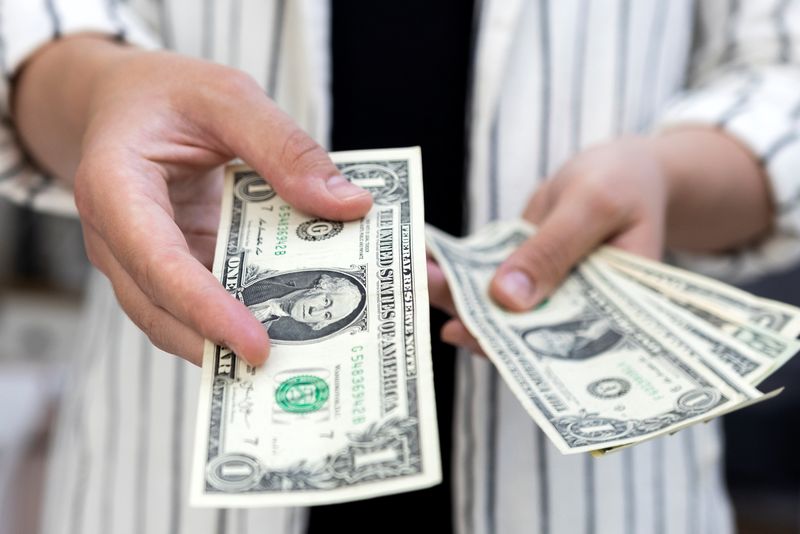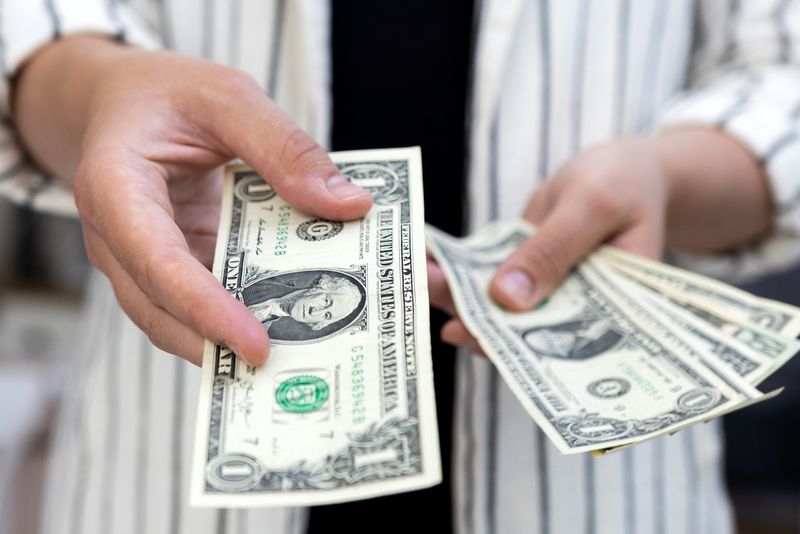
By Stefano Rebaudo
(Reuters) -The U.S. dollar dropped on Thursday after the Federal Reserve cut its interest rate by 50 basis points and revised its monetary policy outlook, with sterling, the Australian dollar and the Norwegian crown outperforming their peers.
Expectations had drifted towards a dovish outcome in the days before the Fed’s decision on Wednesday, with money markets pricing around a 65% chance of a 50 basis point (bp) cut. Economists polled by Reuters were leaning towards a 25-bp cut.
“The Fed’s decision was quite dovish, which bodes well with a rebound in risk and further near-term U.S. dollar weakness,” said Lefteris Farmakis, forex strategist at Barclays.
“The bar, however, is quite high to lean on the Fed for more dollar weakness further out,” he added. “The Fed easing cycle that markets are pricing in is quite significant.”
Money markets priced in 70 bps of additional rate cuts in 2024 and 191 bps by September 2025.
The dollar index, which measures the dollar against a basket of six peers, was down 0.33% to 100.68. It slid to its lowest in more than a year of 100.21 in the previous session.
The big news is “the trimming of growth forecasts and the sharp downward revision of the dots,” said Guy Stear, head of developed markets strategy at the Amundi Investment Institute.
“The Fed seems confident that it has won the battle against inflation, and recognises that monetary policy is now too restrictive, especially given the threats to growth.”
Fed policymakers on Wednesday projected the benchmark interest rate would fall by another half of a percentage point by the end of this year, a full percentage point next year and half of a percentage point in 2026, though they said the outlook that far into the future was uncertain.
The pound hit its highest since March 2022 versus the dollar after the Bank of England’s Monetary Policy Committee (MPC) voted 8-1 to keep rates on hold, with only external member Swati Dhingra voting for a further quarter-point cut.
Sterling was up 0.60% against the greenback at $1.3287 after reaching $1.3314. It was up around 0.4% before the BoE.
It also rose versus the euro, up 0.2% at 84.00 pence and the yen, up 1.12% at 190.04.
The Australian and New Zealand dollars drew support from domestic data surprises.
Australian employment exceeded forecasts for a third straight month in August.
The data “should dispel thoughts of imminent easing from the Reserve Bank of Australia (RBA),” said Robert Carnell, regional head of research, Asia-Pacific, at ING.
“Until recently, there was an odd kink in the implied cash rate curve at the September meeting, indicating that some investors still believed the RBA would follow the Fed lower this month,” he added.
The Aussie was up 0.86% to $0.6822.
“The Australian dollar can receive short term support thanks to the Fed’s dovish approach,” Barclays’ Farmakis said. “The economy’s reliance on China and slow growth outside the U.S., however, raise doubts on the sustainability of the rebound.”
The kiwi, meanwhile, traded 0.74% higher at $0.6253, after data showed the New Zealand economy contracted by 0.2% in the second quarter, compared with the 0.4% fall expected.
Against the yen, the dollar was 0.50% higher at 142.99.
Some analysts flagged a squeeze in short dollar/yen positions as markets took profit post-Fed.
The euro was up 0.35% to $1.1157, but remained below a three-week high hit in the previous session.
The Norwegian crown rose in London trade and strengthened slightly after the central bank kept rates on hold but said it planned to cut in 2025.
It was last up 0.50% at $10.4550 and up 0.93% at 11.66 versus the single currency .

“The statement shifts the dial only very slightly in a dovish direction,” said Andrew Kenningham, chief Europe economist at Capital Economics.
“Policymakers also emphasised that the krone has depreciated and made it clear that this is the key factor keeping them in hawkish mode,” he added.
This post is originally published on INVESTING.


